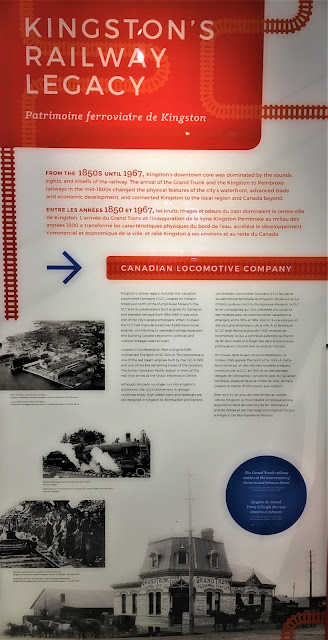It only took four months, but we finally made it to the Pumphouse Museum to view its
On the Move exhibition. Highlighting different modes of transport in the Kingston area, from canoes to sleighs, airports to ferries, taxis and buses, and of course, trains! It was back in April that I delivered my small contribution, a
diorama showing rail and truck transport and commerce at Cataraqui and Rideau Streets in downtown Kingston.
Not only did displays take up the main display space inside the museum, they also extended into niches where the water-pumping steam engines and model train exhibits that are permanent. One could take a guided tour with student guides, but we decided to let our four year-old grandson be our guide, following him to his favourite exhibits.
Interactive exhibits allowed visitors to hear car horns through the decades, make a string map of how far they'd traveled to the museum that day, or watch videos on the history of Kingston Transit. Each type of transport had its own space, with videos, signage, flip-boards holding most of the information, and artifacts under glass.
I'd spoken to curators Tom Riddolls and Jessika Tozer at the end of 2021, when subject experts in each area were being sought for the upcoming exhibition. Though Tom had wanted to tie Kingston into one of the existing O, HO or N operating layouts, I'd opined that would be a challenge. So we agreed on the stand-alone diorama. I also shared some information about some significant events in Kingston's railway history that might fill our the railway coverage.
Though I'd been concerned about the possibility of minor damage to details or structures like the National Grocers building, Woolen Mill and Bailey broom factory(seconded from my own home layout!), Tom had a very secure glassed-in case built around it. Even my grandson could only point, though I'm glad the diorama was at a height that even youngsters could see easily:
Local visitors might recognize the intersection, and if one looked close enough, my Cataraqui and Rideau Street roadsigns were visible in the foreground. Otherwise, there was no interpretation of what the diorama represented. But as I looked around the exhibition, I could see this was the theme - artifacts were presented largely without interpretation, but were clearly integrated into each mode of transport. Tom mentioned that the pandemic staffing challenges and competing priorities have prevented some final presentation additions, but that these will be added.
Tom was especially eager to present original documents with some of the modes, and indeed these were used effectively in railway, road and other areas. The flip-boards were also well-presented and conveniently located in each area. This large graphic oriented visitors to the space, though our grandson got much more out of pushbutton operation of the O and HO trains. Photos from the Queen's University Archives were also part of the large display:
I was interested to see some of the notable events in local railway history highlighted, such as building the Hanley Spur, the Outer Station, the 1968 Turbo crash and even the
zoo train that I'd already blogged about here. Each flip-board had eye-catching graphics, bilingual text and usually a photo or artifact. Just the right amount of information for most attention spans:
The flip-board for the
Turbo crash, about which I'd also blogged on my main Canadian railway blog, Trackside Treasure.
There was a nice blend of the past and present on the flip-boards:
If our grandson were to review his visit, I'm sure he'd list the button-operated car horns as #1! He also enjoyed the Kingston Transit bus mockup and anything that was literally On the Move, such as the stationary steam engine display next door, the trains, and the pushbutton-operated traffic lights (bright up close!).
My review would include a nice balance of all modes as #1. There was inclusion of native canoe builders right through to the Kiewit construction of the Third Crossing bridge. The information presented was historically solid and interesting, the presentation was engaging, the lighting good and the pacing - at your own speed. I could have spent longer, but a thunderstorm gave us good reason to head for the van once we'd been around the exhibition. Adult admission is $7.50 and most visitors can see everything in an hour. Historians, much longer! The exhibition runs until November.
My thanks to Tom and Jessika for including me in this exhibition. Not only did I need to do further research on one of my favourite railway-served areas of Kingston, but it gave me a chance to do some off-layout modelling and get involved in our community museum!
SEPTEMBER 7 UPDATE:
Tom and Jessika have kindly shared my post on the Pumphouse's social media. This picture was taken when I delivered the diorama for display (below). There are some exciting plans for augmenting the exhibit, as well as extending its run!










Very informative blog, Eric. You create miniature masterpieces, and your descriptive writing inspires a visit or two or more to the Pump House. Well done! From Michael Shirlaw
ReplyDeleteThanks for your comment, Mike. This was a fun project and it was nice to see it in its intended environment. We first visited the pumphouse after it opened as a tercentenary project. It remains a unique space even today. Hoping you will enjoy your visit there!
ReplyDeleteEric